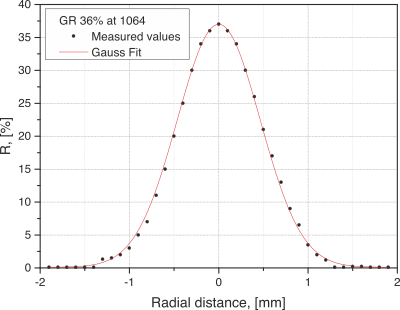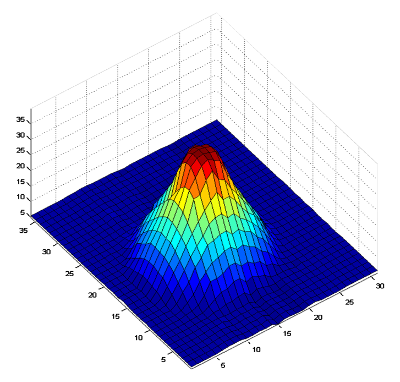Graded reflectivity mirrors (GRM)

Characteristics
The graded reflectivity mirror (GRM) (also known as the variable reflectivity, Gaussian, or super-Gaussian mirror) is a special mirror whose reflectivity at a particular wavelength varies gradually as a function of the position on the mirror's surface.
GRM provides a better modal discrimination in an unstable resonator, i.e. it favors the oscillation of the fundamental mode against higher order modes.
It also improves the optical quality of the output beam especially at low magnifications. The tapered reflectivity profile also leads to a decrease of ripples in the field profile and thus reduces the risk of optical damage when used with high intensity lasers.
Typically, the reflectivity of the mirror is greatest at the centre and decreases towards the edge of the mirror. Crytur offers GRMs with circularly symmetric profiles the reflectivity of which is described by
R(r) = R0 exp (-2(r/w0)N)
where R0 is the central reflectivity, r is the distance from the mirror's centre, w0 is the radius of the reflecting area where R≥R0/e2, and n designates the order of the (super-)Gaussian profile.
Technical parameters
Example of GRM with R0= 36%, w0 = 0.9 mm, n = 3 at λ0=1064 nm.
 |
 |
| Substrate specification | |
|---|---|
| Materials: | optical-grade fused silica or BK7 glass |
| Surface figure: | λ/10 at 633 nm |
| Standard sizes: | ø25.4 × 9.5 mm, ø12.7 × 6.35 mm |
| Specification of Crytur's GRM coatings | |
| Working wavelength: | 1064 nm |
| Reflectivity profile: | nearly Gaussian or super-Gaussian with a specified order n |
| Size of the reflecting area: | w0= 0.5 to 5 mm typically |
| Central reflectivity: | from 5% to 80% (tolerances ±1% to ±5% depending on the reflectivity level) |
| Residual reflectivity: | < 1/20 of R0 or < 0.5% |
| Second side: | appropriate AR coating |
